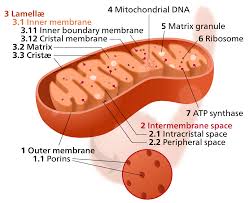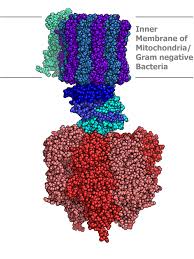INTRODUCTION
- Mitochondria are cylindrical or sausage-shaped double membrane organelles distributed in the cytoplasm
- They are not easly visible under the microscope. Thus, they are stained by a vital stain Janus green to make them visible for observation.
- Mitochondria show a great degree of variability in their shape, size and number.
- Mitochondria are double-membraned organelles found in the cells of most eukaryotic organisms, including plants, animals, fungi, and protists.
- Often referred to as the “powerhouses” of the cell, mitochondria are responsible for producing adenosine triphosphate (ATP), the main energy currency used by cells.
- They carry out aerobic respiration, a process that converts nutrients such as glucose into ATP through a series of biochemical reactions involving the electron transport chain and the Krebs cycle.
- Additionally, mitochondria play roles in other cellular functions, including regulation of apoptosis (programmed cell death), calcium signaling, and synthesis of certain metabolites.
- Mitochondria are believed to have originated from an ancient symbiotic relationship between primitive eukaryotic cells and aerobic bacteria.
Number:- Their number also varies in different cell types depending upon the amount of work done by the cell and its energy requirement.

Structure of mitochondria:-
Double Membrane: Mitochondria have a double membrane structure. The outer membrane encloses the entire organelle, while the inner membrane is highly folded into structures called cristae, which extend into the matrix, the central compartment of the mitochondrion
Cristae: Cristae are the folds of the inner mitochondrial membrane. They greatly increase the surface area available for biochemical reactions, particularly those involved in ATP production through aerobic respiration. The inner membrane, with its cristae, contains the proteins and enzymes responsible for the electron transport chain and ATP synthesis.
Matrix: The matrix is the central compartment enclosed by the inner mitochondrial membrane. It contains a concentrated mixture of enzymes, mitochondrial DNA (mtDNA), ribosomes, and other molecules necessary for various metabolic pathways, including the Krebs cycle (citric acid cycle).

Structure of mitochondria (cont..)
DNA and Ribosomes: Mitochondria contain their own genetic material in the form of mitochondrial DNA (mtDNA), which is circular and double-stranded. They also have their own ribosomes, similar to those found in prokaryotic cells, which enable the mitochondria to synthesize some of their proteins independently of the cell’s nucleus.
Semi-autonomous Nature: Mitochondria are semi-autonomous organelles, meaning they can replicate and divide independently of the cell’s nucleus. They have their own machinery for protein synthesis and DNA replication, allowing them to maintain their population within the cell.
Dynamic Structure: Mitochondria are highly dynamic organelles that constantly undergo fusion and fission processes, which are essential for maintaining their structure, distribution within the cell, and proper functioning. These dynamic processes also play roles in cellular homeostasis, response to stress, and cell death regulation.
Structure of mitochondria (cont..)
Electron Transport Chain (ETC): Embedded within the inner mitochondrial membrane, the electron transport chain consists of a series of protein complexes and other molecules that transfer electrons from electron donors to electron acceptors, ultimately generating a proton gradient across the inner membrane. This gradient is essential for ATP synthesis via oxidative phosphorylation.
ATP Synthase: Also known as complex V, ATP synthase is a molecular machine located in the inner mitochondrial membrane. It utilizes the proton gradient generated by the electron transport chain to drive the synthesis of ATP from adenosine diphosphate (ADP) and inorganic phosphate (Pi) through a process called chemiosmosis.
Mitochondrial Dynamics: Mitochondria continuously undergo fusion and fission processes, allowing them to change shape, size, and distribution within the cell. Fusion merges two mitochondria into one, while fission divides a single mitochondrion into two or more. These dynamic processes are crucial for maintaining mitochondrial health, function, and quality control.
Roles Beyond Energy Production: While mitochondria are best known for their role in ATP production, they also participate in various other cellular processes. These include calcium signaling and homeostasis, regulation of reactive oxygen species (ROS) production, lipid metabolism, synthesis of certain amino acids and nucleotides, and modulation of cell signaling pathways. Mitochondrial dysfunction has been implicated in numerous human diseases, including metabolic disorders, neurodegenerative diseases, and cancer.

Function
- ATP Production: Mitochondria carry out aerobic respiration, a process that involves the breakdown of nutrients such as glucose, fatty acids, and amino acids to produce ATP through oxidative phosphorylation. This process occurs in the inner mitochondrial membrane, specifically within the electron transport chain and ATP synthase complexes.
- Calcium Homeostasis: Mitochondria play a vital role in regulating intracellular calcium levels. They sequester and release calcium ions in response to cellular signals, thereby participating in processes such as muscle contraction, cell signaling, and cell death (apoptosis).
3. Apoptosis Regulation: Mitochondria are intimately involved in the regulation of apoptosis, or programmed cell death. They release proteins such as cytochrome c from the intermembrane space into the cytosol, triggering a cascade of events leading to cell death. This process is tightly regulated and plays essential roles in development, tissue homeostasis, and the elimination of damaged or infected cells.
4. ROS Regulation: Mitochondria are a significant source of reactive oxygen species (ROS) as byproducts of ATP production. While ROS can be damaging to cells in excess, mitochondria also possess antioxidant defense mechanisms to regulate ROS levels and protect against oxidative stress. This balance is crucial for maintaining cellular health and preventing oxidative damage to biomolecules.
5. Lipid Metabolism: Mitochondria are involved in various aspects of lipid metabolism, including fatty acid oxidation (beta-oxidation), biosynthesis of phospholipids and cholesterol, and regulation of lipid storage and mobilization. These processes are essential for energy production, membrane synthesis, and cellular signaling.
6. Heat Production: In certain tissues, such as brown adipose tissue, mitochondria can generate heat through a process known as thermogenesis. This occurs via uncoupling protein 1 (UCP1) in the inner mitochondrial membrane, which uncouples ATP synthesis from electron transport, dissipating energy as heat.
7. Synthesis of Metabolites: Mitochondria participate in the synthesis of various metabolites, including heme, certain amino acids (e.g., glutamate, aspartate), and nucleotides. These metabolites have diverse roles in cellular physiology, including protein synthesis, DNA replication, and signaling pathways.
Funfacts:-
Powerhouse of the Cell: Mitochondria are often called the powerhouse of the cell because they generate most of the cell’s supply of adenosine triphosphate (ATP), used as a source of chemical energy.
Double Membrane: Mitochondria have a unique double-membrane structure, consisting of an outer membrane and a highly folded inner membrane.
Own DNA: Mitochondria contain their own DNA, which is circular and resembles bacterial DNA, suggesting an evolutionary origin from ancient bacteria.
Maternal Inheritance: Mitochondrial DNA is inherited almost exclusively from the mother, as the mitochondria in the sperm are usually destroyed during fertilization.
Endosymbiotic Theory: The prevailing theory is that mitochondria originated from free-living bacteria that were engulfed by ancient eukaryotic cells, forming a symbiotic relationship.
Apoptosis Regulation: Mitochondria play a key role in regulating programmed cell death, or apoptosis, which is crucial for maintaining healthy tissue and organ function.
Energy Production Process: The inner membrane’s folds, called cristae, increase the surface area for ATP production through the electron transport chain and oxidative phosphorylation.
Calcium Storage: Mitochondria store calcium ions, which are important for cell signaling, muscle contraction, and other cellular processes.
Heat Production: In addition to ATP, mitochondria can produce heat through a process called thermogenesis, which is vital for maintaining body temperature in some animals.
Respiratory Enzymes: The inner mitochondrial membrane contains enzymes essential for respiration, including those involved in the citric acid cycle (Krebs cycle) and the electron transport chain.
Diseases: Mutations in mitochondrial DNA can lead to various diseases, known as mitochondrial disorders, affecting energy production and causing muscle weakness, neurodegeneration, and other symptoms.
Dynamic Structure: Mitochondria are dynamic and can change shape, size, and number through processes called fission (splitting) and fusion (joining).
Protein Synthesis: Despite having their own DNA, most mitochondrial proteins are encoded by nuclear DNA, synthesized in the cytoplasm, and imported into the mitochondria.
Cellular Aging: Damage to mitochondrial DNA and dysfunction in energy production are linked to aging and age-related diseases.
Diverse Functions: Beyond energy production, mitochondria are involved in synthesizing certain steroids and lipids, detoxifying ammonia in the liver, and regulating cellular metabolism.
A cell is the basic structural, functional, and biological unit of all living organisms. It is the smallest unit of life that can replicate independently, and cells are often called the “building blocks of life.”
The main types of cells are prokaryotic and eukaryotic. Prokaryotic cells (like bacteria) lack a nucleus and membrane-bound organelles, while eukaryotic cells (like plant and animal cells) have a nucleus and various organelles.
The cell theory states that:
- All living organisms are composed of one or more cells.
- The cell is the basic unit of life.
- All cells arise from pre-existing cells.
Organelles are specialized structures within a cell that perform distinct processes. Examples include the nucleus, mitochondria, endoplasmic reticulum, Golgi apparatus, and lysosomes.
The cell membrane, or plasma membrane, controls the movement of substances in and out of the cell, provides protection and support, and helps maintain the cell’s shape.
Plant cells have a cell wall, chloroplasts, and a large central vacuole, which are absent in animal cells. Animal cells have centrioles and lysosomes, which are not typically found in plant cells.
The nucleus is the control center of a eukaryotic cell, containing the cell’s DNA. It regulates gene expression and mediates the replication of DNA during the cell cycle.
Mitochondria are known as the powerhouses of the cell. They generate ATP, the cell’s main energy currency, through cellular respiration.
Ribosomes are responsible for protein synthesis. They translate genetic information from mRNA to build proteins needed for various cellular functions.
The cytoskeleton is a network of fibers that provides structural support, maintains cell shape, and aids in cell movement and division. It includes microfilaments, intermediate filaments, and microtubules.